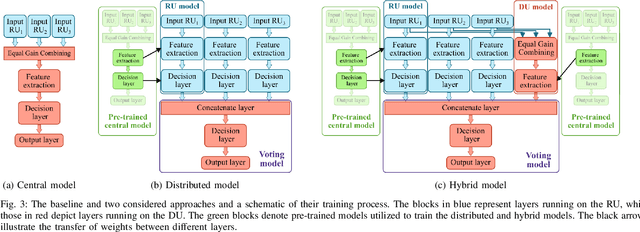Hazem Salluoha
Distributed Deep Learning for Modulation Classification in 6G Cell-Free Wireless Networks
Mar 13, 2024



Abstract:In the evolution of 6th Generation (6G) technology, the emergence of cell-free networking presents a paradigm shift, revolutionizing user experiences within densely deployed networks where distributed access points collaborate. However, the integration of intelligent mechanisms is crucial for optimizing the efficiency, scalability, and adaptability of these 6G cell-free networks. One application aiming to optimize spectrum usage is Automatic Modulation Classification (AMC), a vital component for classifying and dynamically adjusting modulation schemes. This paper explores different distributed solutions for AMC in cell-free networks, addressing the training, computational complexity, and accuracy of two practical approaches. The first approach addresses scenarios where signal sharing is not feasible due to privacy concerns or fronthaul limitations. Our findings reveal that maintaining comparable accuracy is remarkably achievable, yet it comes with an increase in computational demand. The second approach considers a central model and multiple distributed models collaboratively classifying the modulation. This hybrid model leverages diversity gain through signal combining and requires synchronization and signal sharing. The hybrid model demonstrates superior performance, achieving a 2.5% improvement in accuracy with equivalent total computational load. Notably, the hybrid model distributes the computational load across multiple devices, resulting in a lower individual computational load.
 Add to Chrome
Add to Chrome Add to Firefox
Add to Firefox Add to Edge
Add to Edge